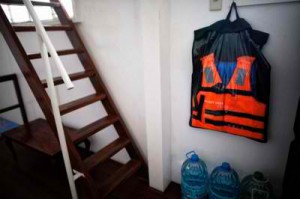By ARTHA KIRA PAREDES
ARISTON Dawang Jr. does not take the strings of floods brought about by typhoons sitting down.
The 70-year-old entrepreneur has gone as far as writing former President Gloria Arroyo and incumbent President Benigno Aquino III–copy furnished to all the senators, members of the congress, and all other officials he thinks who will listen–to recommend disaster prevention and demand accountability.
Dawang, the author of The Book With 3 Titles (How to Stop Corruption, How to Get Rich by Telling a Lie, I Love You Because, has also taken it upon himself to report inefficiencies in flood management in his village.
The former Unilever executive’s proactive stance is understandable. After all, his house located in Provident Village, Marikina City, where he has lived in for 20 years, was almost fully submerged in floodwaters during the heavy rainfall of storm “Ondoy” (international name “Ketsana”) in 2009.
At the height of storm, Dawang had to jump “rooftop to rooftop” to find a safe haven in a neighbor’s third floor basketball court. After Ondoy, he had his house renovated and added what he calls an “escape room” that overlooks most of the houses in the neighborhood.
Ondoy flooded 14 of Marikina’s 16 barangays thus affecting 80 percent of the city’s almost half a million population. Some 68 people were also found dead in Marikina, but more than half of them were non-residents.
Months after the devastation brought about by Ondoy, the Philippine Disaster Risk Reduction and Management Act of 2010 was approved on May 27, 2010.
With his efforts at disaster management, it comes as no surprise that Dawang was driven enough to learn about flood control and send a two-page position paper to President Arroyo entitled “Who is in charge of Flood Control?” in early 2010.
He explained in the letter that heavy rainfall from Marikina and Montalban, flow into the Marikina River, diverted through the Manggahan Channel and impounded in Laguna de Bay then released to Pasig river and Manila Bay during low tide through the Napindan Channel.
After the explanation, Dawang asked Arroyo who is in charge of problems such as flood control system in Montalban, of the reforestation of the Montalban mountains and of dredging the rivers of Marikina, Laguna and Pasig.
He wrote again President Aquino last Sept 30, asking “Who can we turn to for immediate attention?”
The letter was written days after Typhoon “Pedring” (international name “Nesat”) flooded several areas of Marikina again, including Provident Village.
He told the president that the reason Provident village was “waist deep” in flood waters was because the assigned personnel was not able to operate the village’s vertical flood control pump, which is under the City Engineer’s Office.
Much earlier, last June, he reported to Marikina Mayor Del de Guzman that on June 24 during Typhoon “Falcon” (international name “Meari”), the pump in Provident had “no batteries, diesel fuel and no assigned personnel to pump out the flood water which was then fast rising.”
“Please imagine our fear, our concern every time typhoons bring heavy rains and our frustration in knowing that flooding in Provident Village can be prevented if only concerned government agencies will do their jobs,” he urged in the letter to de Guzman.
A pump operator was sent during Falcon when Dawang called Rescue 161 but was unable to operate because the need for battery was not addressed.
Among all the recipients of his letter, only the Department of Public Works and Highways has been prompt in sending a reply. In fact, the agency, with Dawang, conducted an ocular inspection of the river dike and sump pit in Provident.
The DPWH team reported cracks, the suction pump in the pump house was not operational and the water reservoir has been abandoned and has become a health hazard.
Writing to government leaders is not all that Dawang has been doing. He has also taken all the necessary steps to ensure that he is prepared for another flood.
He has installed a flood warning device in his koi pond in his front yard garden that rings before water elevates and gets inside the house.
Dawang’s escape room is also stored with canned goods, flashlights and batteries, gallons of water and at least seven life vests. He is still planning to put bamboo rafts in the roof.
Based on its Disaster Risk Reduction and Management Council Preparedness Program, the city of Marikina is prepared for natural disasters such as typhoons.
Dr. Jenny Fernando, Emergency Management Systems Coordinator, said the program is 18 years in the making. Marikina is ready in terms of facilities, equipment and manpower, but it was “not Ondoy ready,” he said.
Fernando, a member of the Disaster Risk Reduction Management Council of Marikina, said, however, that he would still like to push his proposal for a citywide-community based early warning system that would put water indicators on all posts in the city and a warning bell in every community.
He said the idea behind his proposal is for easier coordination during typhoons and smoother communication when people call the city’s Rescue 161 to inquire about the water level.
“Naghahanap ako ng sponsor (I’m looking for a sponsor),” he said, adding the proposal has already been passed to the United Nations Development Program and the Manila Electric Co. (Meralco).
The United Nations declares Oct. 13 as International Day for Disaster Reduction.
